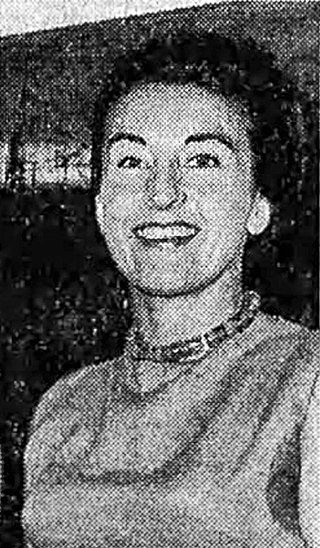
Emily Kame Kngwarreye was an Aboriginal Australian artist from the Utopia community in the Northern Territory. She is one of the most prominent and successful artists in the history of Australian art.

Clara Southern was an Australian artist associated with the Heidelberg School, also known as Australian Impressionism. She was active between the years 1883 and her death in 1940. Physically, Southern was tall with reddish fair hair, and was nicknamed 'Panther' because of her lithe beauty.
Janet Dawson MBE is an Australian artist who was a pioneer of abstract painting in Australia in the 1960s, having been introduced to abstraction during studies in England while she lived in Europe 1957–1960 She was also an accomplished lithographic printer of her own works as well as those of other renowned Australian artists, a theatre-set and furniture designer. She studied in England and Italy on scholarships before returning to Australia in 1960. She won the Art Gallery of New South Wales Archibald Prize in 1973 with the portrait of her husband, Michael Boddy Reading. She has exhibited across Australia and overseas, and her work is held in major Australian and English collections. In 1977 she was awarded an MBE for services to art.

Clarice Marjoribanks Beckett was an Australian artist and a key member of the Australian tonalist movement. Known for her subtle, misty landscapes of Melbourne and its suburbs, Beckett developed a personal style that contributed to the development of modernism in Australia. Disregarded by the art establishment during her lifetime, and largely forgotten in the decades after her death, she is now considered one of Australia's greatest artists.
Francis Roderick Kemp AO, OBE,, known as Roger, was one of Australia's foremost practitioners of transcendental abstraction. Kemp developed a system of symbols and motifs which were deployed to develop a method of manifesting creativity at a fundamental level, striving in particular to explain humanities place in a universal order.

Peter Benjamin Graham, was an Australian visual artist, printer, and art theorist.
Janine Burke is an Australian author, art historian, biographer, novelist and photographer. She also curates exhibitions of historical and contemporary art. She is Honorary Senior Fellow, Faculty of Fine Arts and Music, University of Melbourne. She was born in Melbourne in 1952.
Christine Abrahams Gallery, first named Axiom, was a Melbourne gallery showing contemporary Australian art between 1980 and 2008.
Wintjiya Napaltjarri, and also known as Wintjia Napaltjarri No. 1, is a Pintupi-speaking Indigenous artist from Australia's Western Desert region. She is the sister of artist Tjunkiya Napaltjarri; both were wives of Toba Tjakamarra, with whom Wintjiya had five children.
Aida Tomescu is an Australian contemporary artist who is known for her abstract paintings, collages, drawings and prints. Tomescu is a winner of the Dobell Prize for Drawing, the Wynne Prize for Landscape and the Sir John Sulman Prize, by the Art Gallery of New South Wales.
Normana Wight is an Australian artist, best known as a painter and printmaker.
Louise Weaver is a contemporary Australian artist working in an array of media including sculptural installations, paintings, drawings, printmaking, collage, textiles, movement and sound. She is best known for her installation and sculptures of animals. Weaver's works have been exhibited in Australia and New Zealand and are featured in major collections both nationally and internationally.
Melinda Harper is an Australian abstract artist. She works with a variety of media including drawing, collage, photography, screen printing, painted objects and embroideries. Her work is characterised by the use of colours, stripes and geometrical designs.
Elizabeth Gower is an Australian abstract artist who lives and works in Melbourne. She is best known for her work in paper and mixed-media monochrome and coloured collages, drawn from her sustained practice of collecting urban detritus.
Sanné Mestrom is an Australian experimental and conceptual artist who works mainly in the mediums of installation and sculpture. Mestrom has a research-based practice and incorporates notions of "play" into social aspects of urban design. Since 2011, Mestrom has remade and reinterpreted motifs from the twentieth century modernist art canon. She has earned many grants and has been commissioned to execute public art, sculptures in situ. She has studied in Korea and Mexico, and is a senior lecturer at Sydney College of Art.

Hoda Afshar is an Iranian documentary photographer who is based in Melbourne. She is known for her 2018 prize-winning portrait of Kurdish-Iranian refugee Behrouz Boochani, who suffered a long imprisonment in the Manus Island detention centre run by the Australian government. Her work has been featured in many exhibitions and is held in many permanent collections across Australia.
Diena Georgetti is an Australian contemporary artist born in Alice Springs, Australia and currently based in Melbourne, Australia. Her works have been displayed in galleries across Australia, including the National Gallery of Victoria, the Institute of Modern Art in Brisbane and the Art Gallery of South Australia. She was selected for inclusion in the National Gallery of Australia's Know My Name exhibition 2021-22.
Sandra Leveson, also known as Sandra Leveson-Meares, is an Australian painter, printmaker, and teacher.

Margaret Anne Dredge was an Australian painter and printmaker, active from the mid-1950s until 1997, and teacher of art.

Barbara Nancy Brash was a twentieth-century post-war Australian artist known for her painting and innovative printmaking. In an extensive career she contributed to the Melbourne Modernist art scene, beside other significant women artists including: Mary Macqueen, Dorothy Braund, Anne Marie Graham, Constance Stokes, Anne Montgomery (artist) and Nancy Grant.







